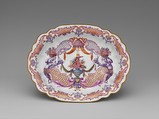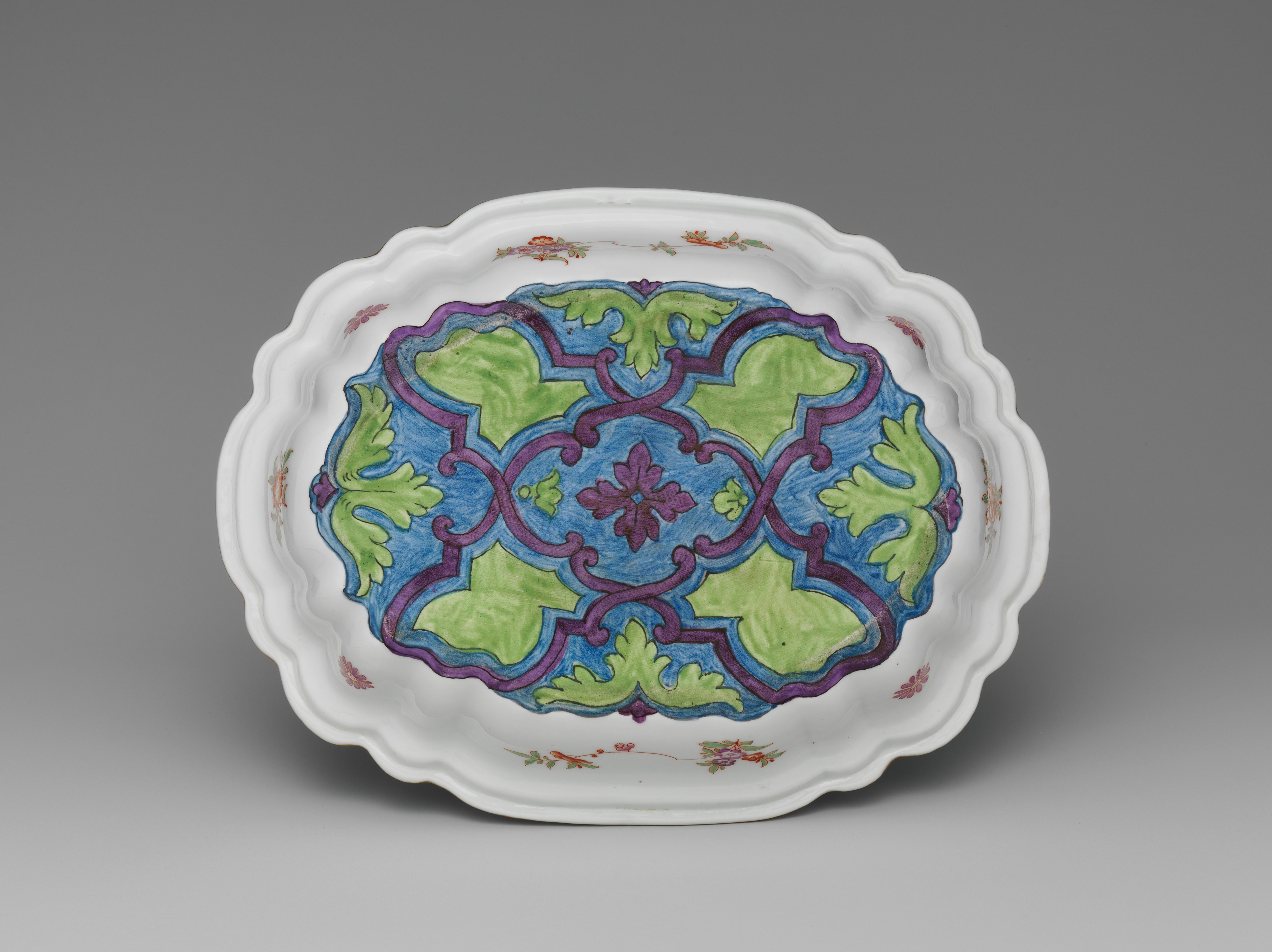Stand for a small tureen
Manufactory Vienna
Factory director Claudius Innocentius Du Paquier period Austrian
The artistic vision manifested in the works produced at the Claudius Innocentius Du Paquier factory beginning in the early 1720s was distinct from any other ceramic enterprise at the time, although this vision defies easy categorization. As a result, the factory’s products are often immediately identifiable even though they reflect a variety of disparate decorative treatments. During the 1730s the factory employed richly patterned decorative schemes that were closely related to contemporary Viennese interior architecture, and this porcelain stand is a superb example of the particular genre. Its immediate visual impact is provided by the large- shaped panels enclosing trelliswork pat-terns painted both along the rim and in the center of the stand. In the latter, the panels are embellished by two tritons supporting baskets of flowers and a central urn with flowers and a bird underneath a baldachin. Swags of drapery, tassels, and foliate scrolls that link all of the decoration complete the composition. This type of overall decoration, which features interlaced scrollwork and often incorporates shaped panels of ornament, is known in German as Laub-und Bandelwerk (“leaf and strapwork”). Many of the Baroque interiors of grand Viennese residences and churches in the early eighteenth century featured Laub-und Bandelwerk decoration either painted or in relief. Large expanses of walls and ceilings were ornamented with panels of decorative strap-work that derived its name from a resemblance to cut straps, and these panels often enclosed trelliswork known as mosaisch (“mosaic”).[1] This type of decoration must have provided inspiration for the painters at Du Paquier, because variants of these schemes were rendered in much-reduced scale but in similar disposition on the factory’s wares. Ornament prints also provided a rich source of motifs for the factory’s painters, and it has been suggested by Letitia Roberts that an etching by the highly influential French-born artist Daniel Marot (1661–1752) may have been the inspiration for the two tritons on the Museum’s stand.[2] The work of the Augsburg printmaker Johann Jacob Baumgartner (German, 1694–1744) has also been cited as an influence for this type of decoration practiced at the Du Paquier factory,[3] since his densely composed bands of ornament have an angularity and visual rhythm similar to those found decorating this stand and other works in this same stylistic vein.
The elaborate decorative scheme on this stand and the skill with which it is painted are enhanced by the subtle but extensive use of gilding. Gold has been employed to highlight the trelliswork in particular, as well as other compositional elements, including the baldachin and the swags below, the central urn, and even the decorative drapery worn by the tritons. Though many works produced at the factory are decorated with a minimal amount of gilding, the generous use of gold on this stand is an indication of the ambitiousness of its decoration. This stand is one of three very similar small oval shallow dishes, all of which are believed to have served as stands for small tureens.[4] It is notable that the decoration of the center of each of the three stands is finely painted and sophisticated in composition, owing to the fact that each would have been largely obscured by the small tureen placed on top.
A remarkable feature of all three stands is the decoration of the underside of each, as enamel colors have been painted directly on the biscuit porcelain rather than on a glazed surface that was customary. Painting on the biscuit produces a matte quality markedly different from that of the luminous effect of enamels applied over the glaze. It is unusual to find enamels painted in this manner on Du Paquier porcelain, and it is unclear why this decorative technique was chosen for the undersides. In addition, it is especially surprising to find designs of this prominence and boldness. On each stand, inter-laced strapwork and acanthus leaves are painted in a striking palette of three colors, and the similarity of these compositions to those of contemporary formal gardens has been noted.[5] As there would be no reason to turn over the stand of a small tureen, it is puzzling why a pattern, perhaps inspired by garden design, would have been chosen to decorate the least visible area of a tureen and stand. However, a distinguishing aspect of Du Paquier porcelain is the use of both forms and types of decoration that have no parallels in decorative arts made else-where in Europe at this time, and it is the presence of these unexpected features that contributes greatly to our appreciation of the factory’s works today.
Footnotes
(For key to shortened references see bibliography in Munger, European Porcelain in the Metropolitan Museum of Art. NY: The Metropolitan Museum of Art, 2018)
1 For two examples, see Lehner-Jobst 2005, p. 38, fig. 11; Zelleke 2009a, 317, fig. 4:20.
2 Letitia Roberts in Chilton 2009c, vol. 3, p. 1288, no. 283. The etching is illustrated in Zelleke 2009a, p. 311, fig. 4:13.
3 Roberts in Chilton 2009c, vol. 3, p. 1288, no. 283. For an ornament print by Baumgartner, see Zelleke 2009a, p. 315, fig. 4:19.
4 Roberts in Chilton 2009c, vol. 3, p. 1288, no. 282. For an example, see Claudia Lehner-Jobst in Kräftner 2005, p. 344, no. 189, ill. p. 345.
5 Roberts in Chilton 2009c, vol. 3, p. 1288, no. 282. For a print illustrating a related garden design of ca. 1724, see Lehner-Jobst 2005, p. 35, fig. 4.
[Note: Shortened citation refers to bibliography in Munger, European Porcelain in the Metropolitan Museum of Art. NY: The Metropolitan Museum of Art, 2018.]
Due to rights restrictions, this image cannot be enlarged, viewed at full screen, or downloaded.
This artwork is meant to be viewed from right to left. Scroll left to view more.





